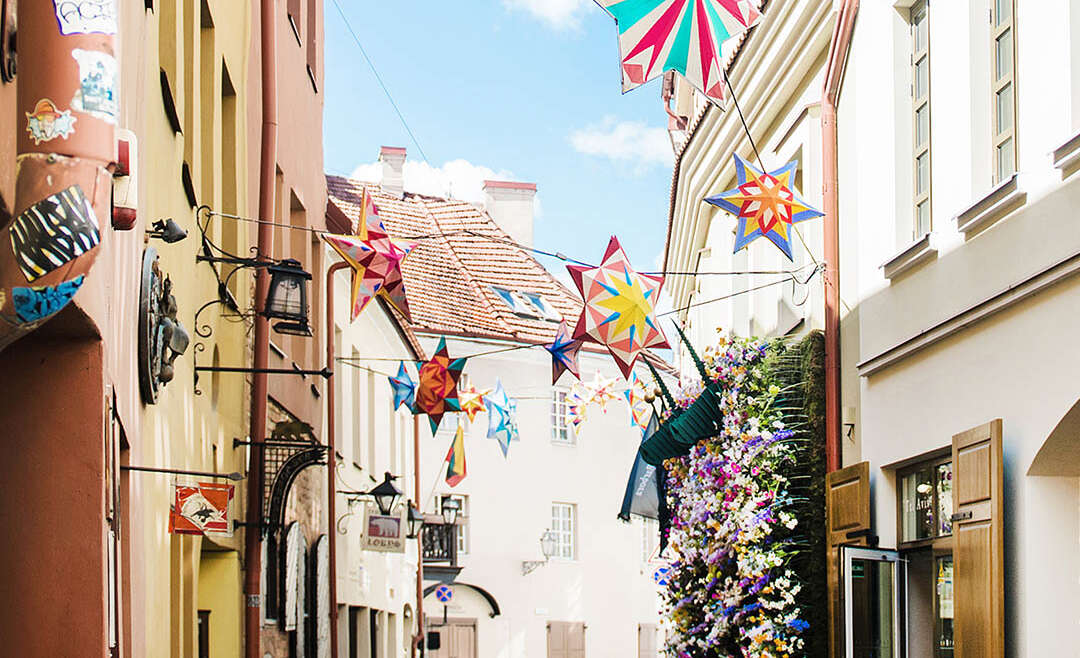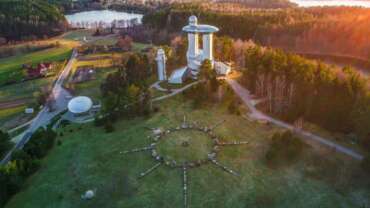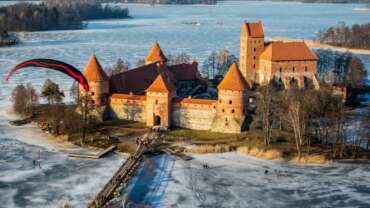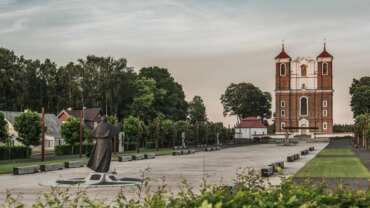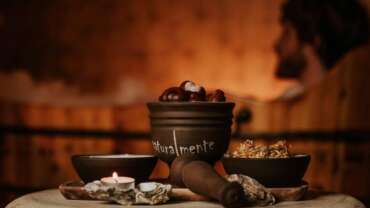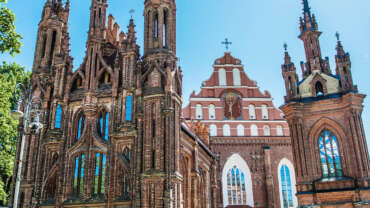Discover Colours of Lithuania
Blue Flag beaches
After tousling your hair, the ferry will take you from Klaipėda to Smiltynė. Riding a bike or taking the pedestrian path, you will spot the blue sea between the pines while you are still up on the hill. Turn through the fragrant grass where you see the Blue Flag flying. Take off your shoes, feel the hot sand under your feet, and scan the area for whatever you need, whether it’s a place to park your bike, a playground, a football pitch or a volleyball court. Don’t worry if your phone dies – you can recharge it at the charging station. The beach even has a special wheelchair so disabled visitors can also go for a swim. If you want to get to a beach faster from the city, go to Melnragė. The second beach also has the Blue Flag flying.
Klaipėda beaches
After tousling your hair, the ferry will take you from Klaipėda to Smiltynė. Riding a bike or taking the pedestrian path, you will spot the blue sea between the pines while you are still up on the hill. Turn through the fragrant grass where you see the Blue Flag flying. Take off your shoes, feel the hot sand under your feet, and scan the area for whatever you need, whether it’s a place to park your bike, a playground, a football pitch or a volleyball court. Don’t worry if your phone dies – you can recharge it at the charging station. The beach even has a special wheelchair so disabled visitors can also go for a swim. If you want to get to a beach faster from the city, go to Melnragė. The second beach also has the Blue Flag flying.
Curonian Spit beaches
This place easy to fall in love with. Once it steals your heart, it won’t let go and will keep tempting and inviting you to come back. There is a reason why UNESCO inscribed the Curonian Spit on the World Heritage List. The peninsula’s vigilantly protected nature, the soft white sand beaches, the fragrant pine air, and the Blue Flag fluttering on the main beaches of Nida and Juodkrantė. This place has everything that fans of pure, natural nature and holidaymakers who enjoy active recreation could need. You can play football and volleyball on the beach, walk along the adjacent pedestrian paths, or rent a bike and take a trip around the Curonian Spit. The lifeguard stations will provide first aid for visitors who are unwell, and the lifeguards will help the disabled go for a swim.
Palanga beaches
Walking along the paths of the old Palanga Park as you take in the centuries-old trees, you will reach the beach near Birutė’s Hill. This is a charming place where there are always less people and more services. The beach is disabled-friendly, and your every step into the sea and every stroke in the water is watched by the vigilant eyes of the lifeguards. There is also a shower where you can wash off the salt of the sea.
Kaunas modernism
Lithuanians are not afraid of grey, as it associates not only with cloudy autumn days but also with the architectural wonders of the XX century that can be found across the country. Young, ambitious and bold. Such were Lithuanian interwar architects. They studied in the large cities of Europe and brought the ideas of Modernism, which spread throughout Europe after World War I, to Lithuania. They combined them with Lithuanian tradition and the typical lifestyle of Lithuanians and created a very distinctive school of architecture. The time was particularly suitable for these experiments – Kaunas became the temporary capital of Lithuania; it was full of political, cultural, economic life, and constructions rapidly changed one another. The spirit of interwar architecture was miraculously preserved in the then exteriors and interiors, and today surprises by modern and contemporary forms. The value of Kaunas Modernism is created not only by buildings, but also by stories and people. This is why all this today attracts not only the connoisseurs of architecture, but also everyone who wish to learn the history of the city and the country. Modernist architecture in Kaunas is already included in the UNESCO World Heritage Tentative List and has great chances to be part of the list itself as “The Capital Inspired by the Modern Movement”.
We invite you to experiment with old-school monochrome filters to get some artsy pics that reveal the true beauty of architectural masterpieces!
Central Post Office
It is one of the major highlights of Kaunas Modernism. A combination of modernity and nationality. A multi-storey building with modern lifts, showers for employees, an electric clock installed in the facade and abundantly decorated works of the then most famous Lithuanian painters. The building was designed by architect Feliksas Vizbaras.
Milk Processing Company “Pieno centras” in Kaunas
Today it is hard to imagine Freedom Avenue (Laisvės alėja) in Kaunas without the multifunctional building designed by architects Vytautas Landsbergis-Žemkalnis and Karolis Reisonas. In the past, the shop of “Pieno centras” and the canteen were opened here, the ladies and gentlemen of Kaunas used to visit the best hairdressers’, and modern apartments were equipped on the third floor. In 1937, the design of Kaunas architects was awarded a bronze medal in the international exhibition in Paris.
Officers’ Palace
The building was built for representation purposes. It is one of the most significant buildings of interwar architecture, and its design was selected from among 30 submitted applications. A decorative exterior and a particularly modern interior – architects planned ventilation and lighting systems with regard to the latest trends in technology. War and occupation showed no mercy for the new and modern building – a field hospital was established in this building, the symbols of statehood were painted over with floor paint, stained-glass was broken, and bas-reliefs were stolen. The Officers’ Palace was again brought to life only with the start of the Reform Movement of Lithuania.
Vytautas Magnus War Museum in Kaunas
In 1930, when the first stone of Vytautas Magnus War Museum was laid in Kaunas, everybody talked that architects Vladimiras Dubeneckis, Karolis Reisonas and Kazys Kriščiukaitis were building a monument to Lithuania’s Independence. The museum very clearly represents the key feature of interwar architecture – a harmonious combination of modernity and tradition. A unique garden space with the eternal flame burning and the bells is established nearby.
Office of the Bank of Lithuania
It is one of the most beautiful, luxurious and significant Modernist buildings across Lithuania. Transaction rooms are on the ground floor and safes with security cameras, installed by Englishmen, are in the cellar. A modern contemporary electric lift, mechanical heating and marble decorated luxurious interior, marble columns, ornate chandeliers, specially designed furniture, artists’ paintings and stained-glass – all this created an unseen interior keeping abreast with the trendiest architectural buildings worldwide.
Christ’s Resurrection Church in Kaunas
This modern church had to provide character to the city of Kaunas, similarly to the Eiffel Tower providing character to Paris. The ambitious project remained unaccomplished, builders failed to complete the church prior to the Soviet occupation, and the congregation could enter it only after independence was restored.
RYE BREAD BLACK
Old crafts
Everything in this world is changing, but it’s nice that some things are not. Traditional crafts are full of magic and they are very popular in Lithuania. The people who have kept the secrets of their family’s craft for centuries are truly amazing. They throw ceramic ware the exact same way their ancestors did hundreds of years ago, and then fire it in a kiln with real fire, the exact same way their grandparents did. In Lithuanian villages, we can still find looms that our great-grandmothers used to weave their dowry. Today, ancient Baltic weaving patterns have taken on new meaning and a new life. Likewise, people still hang wooden crosses carved according to ancient tradition in their homes, still own carving of the Pensive Christ, and still stir jam on modern stoves with wooden spoons. Blacksmithing has always been an exceptional craft in Lithuania. Having earned respect, artisans now use their talented hands to decorate our homes and surroundings. You can see these crafts at the folk art fairs that are so popular in Lithuania, or you can learn old crafts during educational programmes held by museums or the artisans themselves.
Make pottery
What a thrill to pick up a bowl that was just recently a piece of clay! Or to drink fragrant tea from a cup you made yourself. Adults equate kneading clay with meditation, while for kids it is a great lesson in Lithuanian crafts. In Dzūkija, Merkinė has long been known for its black ceramics, and there are still talented artisans in Kernavė as well. They won’t just tell you the story of one pot there – they’ll tell you the entire history of ceramics, and show you how to mould and throw pottery.
Weave a towel
This educational programme is for people who think that towels are sold in the store. Programme participants are taught about the art of weaving, Lithuanian motifs, weaving techniques and fabrics. Obviously, the most interesting part is trying your own hand at weaving.
Felting
“Warm as a lamb” – an interesting activity where both children and adults can learn the most important things about sheep, what is sheared, and what is done with the wool. A tiny brooch, a necklace, a sauna hat, or felt boots – learn a new craft! Maybe you’ll like it? After all, every hobby has to start somewhere.
Weave a basket
Maybe your first basket won’t come out perfect, but trying your hand at wicker weaving, like our ancestors used to do to make the long winter evenings a little bit shorter, is definitely worthwhile. As you strip the willow rods, you will hear stories about what weaving materials have been used since ancient times, how the willow rods are prepared for weaving, and what things can be made from them.
Make a candle
Have you ever felt what a real wax candle smells like? What a magically soothing aroma it emits? Candle makers will show you the very oldest method of candle making, and tell you about candle traditions and their significance in Lithuanian culture. And you can light the candles you make yourself at home or bring them back as souvenirs.
Make a straw garden
A straw garden used to be hung above the table where the family would gather three times a day. Created by hand, this delicate structure is believed to bring harmony, cosmic energy, and sacred tranquillity to the home. Straw garden workshops are available where you can learn the subtleties of their creation and decoration. And not just gardens, but also straw birds, garland, and stars that can be hung on a Christmas tree – you can make all that with your own two hands.
Learn to read a weathervane
Curonian weathervanes are a unique part of the heritage of Lithuania’s coastal region, with details and ornaments from traditional fishing boats marked with symbols and meanings. You can take them and read them like a book – they reflect the story of the fisherman’s life. Attend a workshop to learn about why weathervanes came about, the subtleties of how they are made, and the meanings behind their colours and patterns.
Make your own amber amulet
Amber is the gold of the Baltic Sea. Each piece is unique, so each piece of amber jewellery is too, highlighting the personality of the person wearing it. Workshops are offered during which participants can make their own amber amulet or other piece of jewellery using ancient technology.
Leave a cross
A traditional branch of Lithuanian folk art that unites faith with workmanship, cross-crafting (kryždirbystė) has been proclaimed a Masterpiece of the Oral and Intangible Heritage of Humanity by UNESCO. This craft was never taught in special schools. The crosses were – and still are – made out of wood, metal and even stone by self-taught artisans. Learn about cross-crafting traditions and make your own cross that you can leave on the Hill of Crosses among the thousands of symbols of faith left by other people.
Make your own Užgavėnės carnival mask
At the Plateliai Centre for Traditional Crafts, you can make your own carnival mask that you can wear during Užgavėnės (Fat Tuesday) – in Plateliai, this festival is celebrated every year with a bang and Užgavėnės customs are followed very faithfully. For example, they say that you simply must make a new mask every year, since your neighbours might recognise your old one!
You can also visit the Lėčynų Museum in Plateliai where you can see over 300 different traditional lėčyna (the Samogitian term for the Užgavėnės carnival mask).
Taste bread
Kneaded by caring hands, put in a warm place to rise, and then baked among hot coals before making it to our table, this loaf of bread smells different. And it tastes different too. Don’t believe it? Follow the path bread takes, from the rye field to the table, and see for yourself. Try sweeping out the oven, piling the coals, kneading the dough, and putting it into the oven. And then later, sit down at the table and take a bite of a fragrant slice.
VILNIUS ROOFTOP RED
Cosy. Colourful. Full of culture and life. Romantic and engaging. Vilnius is all this and much more. So if you are looking for a respite from routine or a fresh breath of inspiration, Vilnius welcomes you.
Rich in spirit and a trove of hidden treasures, Vilnius is a city that entices and invites you to explore it all day and all of the night. From the mysterious courtyards of the Old Town and the sculptures that inhabit them, to the city’s melting pot of architecture styles, and the multitude of green spaces that are scattered liberally throughout the city, Vilnius offers much to explore during the day, while at night the city comes alive with the buzz of the downtown’s many bars. And it is here, in the small hours that strangers become friends. Vilnius is not a city that you can plan for. It is a city to be experienced and a city to love.
Your perfect escape plan. First, take a flight to Vilnius or arrive by bus or even by train, then jump in a taxi. You’ll find yourself in the heart of the city in ten minutes. From there you can settle into one of the city’s many charming red-roofed apartments. After a specially brewed coffee from one of Vilnius’s many cosy cafes, you are ready to explore.
AMBER YELLOW
The miracle that the sea gives us. A fossilized drop of tree resin in which the forces of the millenniums and nature’s elements lie. Our ancestors used to say that amber protects you from evil people and encourages creativity. Maybe that’s why people are so fond of amber jewellery, and artists decorate precious metals with the “sun stone”. Ancient uses have now found their place at modern spas, where amber incense is used for aromatherapy, and amber dust is added to creams.
DEEP FOREST GREEN
Educational hiking trails
How to feel closer to the pureness of nature in Lithuania, how to touch it, smell it, taste it? Try an educational trail! Don’t hurry – choose from over a hundred and fifty cognitive walkways set up in the most beautiful corners of Lithuania. Walking along those trails, you will not only see the most interesting natural objects, but also hear millions of sounds of the Lithuanian forest, dispel the mystery of the wetlands, and at a moment of repose refresh yourself with water from our streams or springs.
Čepkeliai Marsh Educational Trail
The 1.5 km long path made in the marsh (visited only with a guide from April 1 to July 1) makes it possible to have a sneak peak at one of the most protected natural areas in our country – the largest bog with a causeway in Lithuania – the Čepkeliai Marsh. When walking, you will see continental dunes, get acquainted with the local vegetation, and look at the large misty swamp from the observation tower.
Kamanai Educational Trail
It is prohibited to visit this reserve in northern Lithuania on your own, so this 4 km path, available only with the escort of a guide, gives a unique opportunity to see protected animals and plants in their natural environment; for example, a species of sundew that can only be found in Lithuania. The 30-meter-tall observation tower built next to the trail will reward you with a panorama of the Kamanai marsh and the flat plains characteristic of this part of the country.
Cognitive Walkway of Mūšos tyrelis
The 3.6 km path located in Žagarė Regional Park is unique because it is the longest boardwalk in Lithuania. Such a long raised trail is a real discovery for those who are interested in bogs’ ecosystems, as it makes it possible getting acquainted with the vegetation and wildlife of the bog in its natural environment, to enjoy the silence disturbed only by only the inhabitants of the bog, such as the black grouse, gray cranes, and geese.
The Jurkiškis River Cognitive Trail
Although Lithuania cannot boast of high mountains, you will surely hear the sound of mountain rivers here! Only 1.2 km long, the canyon-type Jurkiškis river connects the lakes of Asveja and Suoselis. Due to the hilly surface, and the difference in height, especially during the spring flood, it resembles a real mountain creek. You can enjoy its beauty by traveling on a 1.5 km walkway that has plenty of steps and overpasses.
Cognitive Trail “Barsuko ola” (Badger’s Hole)
In this rather short (700 m), but diverse in terms of terrain, geological trail you will not only exercise your legs, but also get acquainted with a unique phenomenon of Northern Lithuania – sinkholes that form when groundwaters wash out the underground gypsum strata. Going down the trail, up and down the steps and overpasses, you will see 13 different sinkholes – some of them rather simple, while others have a more complex form, some of them separate, while others interconnected from the outside and even the inside.
Šaukliai Boulder Cognitive Path
Walking down the 2km walkway built on this spectacular moraine, can make you feel as if in a tundra! The boulder field, formed by the last glacier 26 thousand years ago, has not been touched by economic activity. Thus the unique landscape of this area with stones, whose diameter can be as large as 3 meters, creates a breathtaking impression. And if you believe in the legend of the origin of this place that says that the boulders are Swedish soldiers turned into stone by pagan gods…
Zackagiris Cognitive Trail
The 13.8 km trail that bears a beautiful Dzūkian name is one of the longest in Lithuania, but you can choose shorter sections of 7 or 10.5 km. The trail runs along sandy riverbanks with beaver houses, dunes, mysterious swamps, and rustic forests. All the natural diversity of this region of Lithuania is revealed before your eyes!
Žagarė Esker
An esker is a long, narrow hill, shaped by glaciers from sand and gravel. Žagarė esker, surrounded by the plains of Northern Lithuania, is one of the most impressive natural sights in Lithuania. You will be able to get acquainted with the surroundings by visiting the 3.6 km cognitive path that runs along Žvelgaitis Hillfort, the esker, the lake, as well as the banks of the River Švėtė.
Nagliai Cognitive Trail
The 1.1 km trail of the Nagliai Nature Reserve will lead you through a mysterious natural phenomenon – dead sand dunes. This is where four former Curonian Spit villages were buried in the sand a few centuries ago. Strong winds here create a unique landscape – hollows and washouts, revealing the soil of an ages-old forest buried in the sand.
Aukštumala Educational Trail
Walking more than a kilometre along the surface of the raised bog would be impossible if it wasn’t for one secret: the trail that has been constructed along the kūlgrinda – an ancient underwater road of stones that went through the swamps. Once a secret way to escape from attackers, it now gives us the opportunity to learn about the flourishing flora of the raised bog and to admire its distinct landscape from right up close.
Ecological Cognitive Trail “Litorina”
When traveling down the trail that begins by the impressive bluff known as Dutchman’s Cap and continues for another 3 km, you’ll be able to look the Baltic Sea from a height of about a dozen meters! Walking along the ancient Littorina Sea coast, you will find information about the geological structure of the seaside, the tree species growing there, atypical for Lithuania, and the historical peculiarities of the location.
Lake Žuvintas Nature Trail
The route is intended for those wishing to get acquainted with the pride of the South of Lithuania – the lake of Žuvintas, famous for its floating islets and an extremely rich variety of birds. During the warm season, the 350 m boardwalk made between the reeds, allows you to listen to the impressive choir of the winged population of Žuvintas. At the end of the trail, there is an observation tower, from which you can conveniently observe over 200 species of migratory birds living in the lake!
Juniper valley
This 1.3 km walk along the steep slope of the Nemunas is one of the most popular in Lithuania. While walking it, you will not only be able to marvel at the scenic views of the largest artificial water body in Lithuania – Kaunas Lagoon, but also breathe in healthy air. The junipers growing abundantly in the vicinity of the trail, emit a large amount of disinfecting and healing substances, so the air in the valley is extremely pure.
Dubrava Educational Trail
Located near Kaunas Reservoir, the Dubrava Reserve covers an area of more than 120 hectares and features a breathtaking education trail. Nearly two kilometers long, the trail has eight information boards about the extraordinary wildlife you are walking through.
Pūčkoriai Cognitive Trail
The 5 km walkway in Pavilnys Regional Park in Vilnius, is a great place to hide from the bustle of the city. From the impressive 65-meter-high Pūčkoriai outcrop, you can admire the view of the Vilnelė river running down below and the forests surrounding it, and, after descending into the valley of the river, familiarize yourself with the historical and cultural objects, and then go up to the Pučkoriai Hillfort.
Varnikai Cognitive Trail
The historical capital of Lithuania, Trakai, extremely rich in historical sites, has something for nature lovers too. The 3.5 km long winding path over the bog in Varnikai forest leads away from the noise of the city to the most interesting places of this natural area: the Ilgelis swamp, tiny lakes, and a beautiful forest. Enjoy the blueberries, lingonberries, wild strawberries, cranberries, and the sounds and scents of the forest!
COLD PINK
Unexpected gastro experiences
The different regions of Lithuania are chock-full of unexpected flavours and gastro experiences. Each regional kitchen in Lithuania has its own traditional dishes that differ in character. Join educational routes to know more about Lithuanian cuisine, try new dishes and enjoy original drinks. Let’s start gastro tourism and discover Lithuania with our taste buds!
A taste from the past – Kaunas Spurginė
In this fast-paced world, it’s unreal to find places where time seems to stand still. One of them is Spurginė, which is still in operation on Laisvės Alėja in Kaunas. Over the course of almost four decades, neither the interior, nor the staff, nor the doughnut recipes have changed.
Drink an unforgettable cup of coffee in Vilnius
The Old Town of Vilnius is cosy and small, but there is so much to see that you definitely have to recharge by savouring a cup of coffee. There are a growing number of cafés in the city that focus a lot of attention on the origin and quality of the beans they use, and which offer different brewing methods and even organise gatherings for coffee amateurs and professionals. The cafés in Vilnius are scattered throughout the city – you can find them tucked away in the small streets of the Old Town or in book stores and shopping centres. Lithuanians are true coffee connoisseurs. For Lithuanians, a cup of coffee is a source of energy and a symbol of friendship. Lithuanian coffee chains like Huracán, Caffeine and Vero Cafe have created a real network of coffee shops throughout the city (and the country). Over the past few years, coffee culture has flourished in Vilnius and the capital now has something to show its guests: from the Good Coffee Map for coffee lovers to the Vilnius Coffee Festival, which is the largest coffee festival in the Baltics.
Fish Road
There are a lot of opinions about traditional fish soup, but they say the most authentic recipes can be found in the Pamarys Region. The locals in Dreverna (Klaipėda District) offer the popular Fish Road programme, where you can enjoy soup made with fish from the Curonian Lagoon or other local fishermen delicacies right on the deck of a ship!
Zanavykija Taster
Do we know a lot about regional cuisine? Even Zanavykija – the part of the Suvalkija region that surrounds Šakiai – has such a rich and belly-rubbing heritage that once you try it, you want to do it again and recommend it to others. And the king of the table in Zanavykija is a meat-stuffed cabbage head baked in a wood-fired oven! Its taste reminds you of cabbage rolls, but its appearance speaks highly of the chef. If you would like to learn about the food of the Zanavykija region, you can book the Zanavykija Taster culinary educational programme offered by Kuchmistrai Restaurant at Zypliai Manor.
The richest pancakes – Panemunė Dzūkian Cottage in Punia
The Panemunė Dzūkian Cottage in Punia (Alytus District), where the living environment of Dzūkians in the late 19th century has been recreated, offers an educational programme during which visitors can grind flour with old-fashioned tools and make pancakes according to an authentic recipe. They also make banda here – a unique Dzūkian savoury cake made from grated potatoes and baked in a bread oven on a cabbage leaf. Banda are served with darycinis made from homemade curd cheese and cream.
Spring straight from the trees
Lithuanians drink amber tea, nettle wine, blueberry kvass and dandelion coffee, and they extract so much mineral water they can bathe in it. And, every spring, they drink juice from the trees.
Seasonal food is the main characteristic of Lithuanian cuisine. The sap from maple or birch trees has for a long time been the first natural treat of the year. The time to enjoy this slightly sweet nutritional drink, one sip of which embraces an entire waking forest, is the month of March.
A bird is first to drink
Renata Ničajienė, author of culinary books, also writes a popular city website on seasonal cuisine. She is fond of sap: “From my childhood I remember that my grandmother always stored birch sap in spring. My mother’s grandparents, who lived in a village in the region of Dzūkija, kept a large barrel in their basement which they filled with birch sap each spring and sprinkled oats on top. Over time the oats would sprout, naturally protecting the sap against fermentation or mould. This way the preserved sap could be used throughout the spring and summer.
We tap birch sap in March, but the process mainly depends on the weather. It’s only when the temperature rises above zero (about +5° C) and the sun comes out that the sap begins to flow. It normally lasts for a few weeks. One spring day I discovered quite accidently that the sap was ready. I noticed through my cottage window a bird tapping a hole in the trunk of a maple tree and sipping the sap. I understood it was high time to tap it myself. Drilling a small hole in a tree can produce two to four litres of sap, then we press in a wooden plug and cover the wound with paste. If the nights are still cold, the sap freezes and does not flow overnight. The tastiest and sweetest sap is the very first sap taken from a tree.
Since sap can last in a refrigerator for up to five days, to prolong its use it must be fermented or preserved. It can also be frozen. I usually ferment it by adding raisins or some blackcurrants”.



